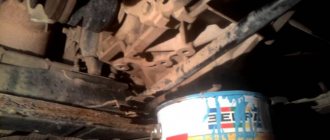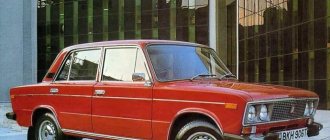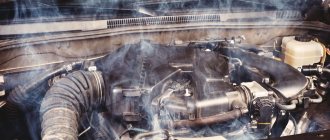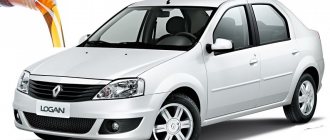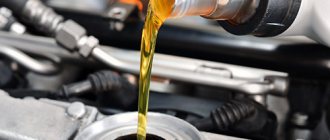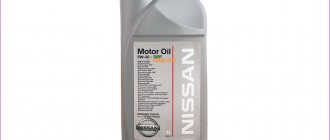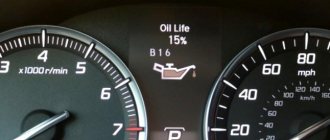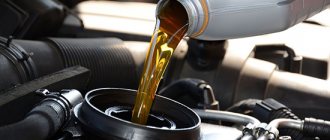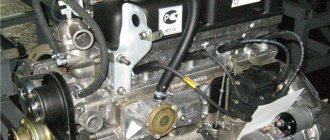Array ( [DATE_ACTIVE_FROM] => 08/19/2020 10:10:00 [~DATE_ACTIVE_FROM] => 08/19/2020 10:10:00 [ID] => 509222390 [~ID] => 509222390 [NAME] => ZIL refueling volumes 130 [~NAME] => ZIL refueling volumes 130 [IBLOCK_ID] => 33 [~IBLOCK_ID] => 33 [IBLOCK_SECTION_ID] => [~IBLOCK_SECTION_ID] => [DETAIL_TEXT] => The ZIL-130 dump truck began to be produced in 1964. And this model can still be seen on the roads of post-Soviet countries. The truck still performs its main function - transporting goods, mainly construction materials and agricultural products. The vehicle is inferior to modern dump trucks in many characteristics, but it is on the move, and with proper maintenance does its job with dignity. By competent maintenance we mean maintenance, which includes changing the oil in the gearbox. Those who repair the truck themselves should know how much oil is needed in the ZIL-130 gearbox, what fluids to use and with what frequency.
Features of the dump truck
The ZIL 130 model was designed and assembled at the Moscow Likhachev plant since 1964. The truck is immediately recognizable - the large cab, painted blue with a white front, is familiar to anyone over 30 years old. The dump truck took 6 years to design, and at the time of release it was an innovative model with a spacious, comfortable cabin, power steering, synchronized gearbox, and an eight-cylinder four-stroke V-twin engine of 6 liters. The car received a heated engine and a glass washer - in those years this was a new product. The truck was also pleased with its efficiency - it is unpretentious in terms of fuel quality, consumes 30 liters per 100 km, and the filling volumes of the ZIL 130 are small. The dump truck turned out to be productive, durable, a real “hard worker”, which was more convenient to drive than previous ZIL models. The medium-duty truck was not inferior to models from Europe and the USA. In 1973, the truck received the State Quality Mark, the award was well-deserved - hundreds of enterprises, farms and organizations sent thanks and reviews. In the fields, steppes, and conditions of the Far North, the ZIL 130 coped with its tasks perfectly. Today, the loud, bumpy and tough old man is losing ground, giving way to modern trucks. But it is not written off - the unpretentiousness, ease of repair and endurance of the machine becomes an advantage where there are no high requirements for comfort or accuracy of cargo transportation. ZIL-130 was produced at the Moscow plant until 1994. Afterwards, its production was transferred to the Ural AMUR plant, and until 2010 AMUR-531350 dump trucks rolled off the assembly line. The name is new, but the car is the same.
Modernization
The cars, which were produced from 1964 to 1966, received carburetor engines with a power of 148 hp. With. The load capacity was up to 5 tons on asphalt or concrete, and up to 4 tons on primer, and the service life reached 135,000 km - before major repairs. Modernization in 1966 gave the car a 150 hp engine, increased the service life to 200,000 km and the load capacity to 5 tons on any road. The changes did not affect how much oil is required in the ZIL gearbox. The next modernization, which was carried out 10 years later, increased the load capacity of the dump truck to 6 tons and increased the service life to 300,000 km. Truck tractors were produced on the basis of the truck, which were used to tow trailers weighing 10-14.4 tons.
TECHNICAL SPECIFICATIONS OF ENGINE
Basic data ZIL-130
Number of cylinders 8
Cylinder arrangement V-shaped
Operating order 1-5-4-2-6-3-7-8
Displacement l 6,000
Compression ratio 6.5
Power kW (l, s) 110
(150)
RPM at maximum power 3100
Gearbox ZIL-130
The unpretentiousness of a car does not mean a complete lack of maintenance; this also applies to the gearbox. The ZIL 130 is equipped with a five-speed manual gearbox. The 3rd, 4th and 5th gears are engaged through two inertial synchronizers; in addition to them, a primary, secondary and intermediate one are installed. The double final drive of the box is equipped with two bevel wheels with spiral teeth and two cylindrical wheels with oblique teeth. Gear ratio – 6.32. In addition to 5 forward gears, the gearbox has 1 reverse gear. How much oil is in the ZIL gearbox depends on the year of manufacture of the car, but with an engine of 150 hp. The oil volume in the gearbox is 5.10 liters. This figure should be used as a guide when performing maintenance or changing the oil.
How much oil is in the ZIL 131 engine
» Articles » How much oil is in the ZIL 131 engine
| Filling/lubrication point | Volume, l | Name of material/liquid |
| Fuel tanks | 2x170 | Gasoline A-76 |
| Cooling system | 29 | Antifreeze A-40 (water allowed) |
| Engine lubrication system | 9 | All-season up to minus 30°C - oils M-6/10V (DV-ASZp-YuV) and M-8V, at temperatures below minus 30°C oil ASZp-6 (M-4/6V,) |
| Hydraulic steering system | 3,2 | Oil grade P |
| Gearbox (without power take-off) | 5,1 | All-season oil TSp-15K, at temperatures below minus 30°C oil TSp-10 |
| Transfer case | 3,3 | All-season oil TSp-15K, at temperatures below minus 30°C oil TSp-10 |
| Main gear housings for driving axles | 3×5,0 | All-season oil TSp-15K, at temperatures below minus 30°C oil TSp-10 |
| Winch gear housing | 2,4 | All-season oil TSp-15K, at temperatures below minus 30°C oil TSp-10 |
| Shock absorbers | 2×0,45 | Shock-absorbing fluid AZh-12T |
Order a book on repair and operation
Oil change schedule
Oil in a manual transmission not only lubricates moving elements, it is a working fluid. The ease of gear shifting and the service life of the gearbox components depend on the characteristics of the fluid. The frequency of changing the transmission fluid depends on the following factors:
- The type of oil used is mineral, synthetic or semi-synthetic.
- Oil quality.
- Car mileage.
- Terms of Use.
- Emergency situations.
The type of liquid is discussed below. The quality of the oil depends on the brand - ZIL is unpretentious, but you still shouldn’t pour low-quality liquids into it. When using mineral fluids, they are replaced once a year or after a mileage of 100,000 km. If synthetics are used and the gearbox is not equipped with an oil filter, the regulations are increased to 480,000 km. If the gearbox has a filter, the oil is changed every 800,000 km, the filter itself - 160,000 km. These are recommendations for trucks that are used outside the city or in difficult conditions. When driving around the city, a reduction factor is used, regardless of how much oil is in the ZIL 130 box. For ZIL models, the recommended mileage limit is 30,000, when using mineral transmission fluids. It is necessary to replace the fluid, regardless of mileage, in the following cases:
- water got into the box;
- Poor quality oil is poured;
- the liquid has darkened and lost its transparency;
- there is a burning smell;
- there is foam or bubbles in the liquid;
- gearbox lubricant leak;
- noise when driving the car and changing gears;
- difficulties when changing gears;
- spontaneous shutdown of transmission.
It is recommended to change the fluid in the fall, so that the truck is operated in cold weather with fresh oil - it changes properties with temperature changes.
Engine cooling system
Engine cooling system, liquid closed type, with forced circulation of coolant.
For normal engine operation, the coolant temperature must be maintained within 75...95 degrees.
In a warmed-up engine, coolant is sucked from the radiator into the liquid pump and, under a certain pressure, through two pipes of the pump is supplied to the left and right cylinder blocks and, passing through the windows in the inter-cylinder partitions, cools the cylinder liners.
cooling system
ZIL-130 ENGINE LUBRICATION SYSTEM
LUBRICATION SYSTEM
The lubrication system (Fig. 3.5) includes: oil filler neck, oil pan, oil pump with oil receiver. filters, oil cooler, lines, channels, oil dipstick and crankcase ventilation system.
The engines under study use a combined lubrication system, in which the most loaded parts are lubricated under pressure, and the rest by splashing and gravity flow.
Oil from the oil sump is sucked in by the oil pump through the oil receiver and flows from the discharge section of the pump into the oil filter and then through the main oil line to the crankshaft and camshaft bearings. Then it is supplied through channels in the block and cylinder heads to the rocker arm axles, rocker arms and to the compressor (in ZIL-130 and -645 engines).
The crankshaft main and connecting rod bearings, camshaft journals, valve axles and rocker arms, ignition distributor and oil pump compressor drive shafts are lubricated under pressure.
The cylinder bore and piston pins are splash lubricated. Camshaft gears, valve stems, lifters and camshaft lobes are gravity lubricated.
To maintain oil pressure within specified limits, the lubrication system is equipped with safety and bypass valves.
Lubrication system
ENGINE POWER SYSTEM
The Engine power system includes instruments and devices designed to store reserves, supply and purify fuel, purify air, prepare a combustible mixture of the required composition and remove combustion products. The power system (Fig. 441) of a carburetor engine includes: carburetor, fuel tank, fuel filters, fuel pump, fuel lines, air cleaner, intake and exhaust pipes, muffler.
The 3M3-53-11 and ZIL-130 engines are equipped with two-chamber carburetors K-126B and K-88AM, respectively.
engine power system
TRANSMISSION
clutch ZIL-130
The clutch (Fig. 7.1, a) on the cars under study is frictional, single-disk, located in a casing 12 attached to the flywheel 3, which serves as the clutch drive disc. Inside the casing there are the following parts: driven disk 4, pressure disk 5, which is connected to the casing using protrusions on the disk (for the GAZ-5342 car) or spring plates (for the ZIL-431410 and ZIL-645 cars), ensuring axial movement of the disk relative to clutch release housing; clutch release levers 6, pivotally mounted on needle bearings. The driven steel disk 4 with friction linings attached to it is connected through a torsional vibration damper to a hub 7 mounted on the splines of the drive shaft of the gearbox. The torsional vibration damper ensures smooth engagement of the clutch and rapid damping of torsional vibrations due to the elasticity of the springs 10 and the friction between the damper discs 9 and driven disk.
clutch
BRAKE CONTROL
ZIL vehicles use a braking system with a pneumatic drive (Fig. 10.5), which includes wheel brake mechanisms and pneumatic drive circuits for the working, parking and spare brake systems. The brake system of the ZIL-4331 vehicle, in addition, includes a brake mechanism and a pneumatic drive circuit for the auxiliary brake system (engine brake).
The brake mechanisms (Fig. 10.6) of the service brake system are installed on all wheels. The brake mechanisms of the rear wheels are common to the service, parking and spare brake systems.
The brake mechanisms are installed on calipers, which are attached to the flanges of the front axle axles with bolts, and to the flanges of the rear axle housing with rivets. Brake pads 2 with friction linings are installed on the eccentric axles fixed in the caliper. The axles 8 of the pads have eccentric supporting surfaces, allowing them to be correctly centered with the brake drum 7. When braking, the pads are moved apart by an expanding fist 4, and when released, they are tightened by springs.
Shaft 15 of the expansion fist (Fig. 10.7) rotates in a bracket bolted to the caliper. At the splined end of the shaft there is an adjusting lever with a worm gear 16 and a worm 14 located inside it, secured by a lock 17. The adjusting lever is connected to a membrane 3, installed between the body and the brake chamber cover, using a fork 11 with a pin 12 and a rod, and ensures a reduction in gaps between the brake pads and the drum, increasing as a result of wear of the friction linings.
brake control
CABIN ZIL-130
The cabin of ZIL-433360 vehicles is all-metal, three-seater, with a whole panoramic non-opening glass wind window of the “Triplex” type.
The cabin doors have sliding glass and rotating window windows. Raising the door windows and securely fixing them in the raised position is carried out by single-lever window lifters.
The cabin doors, left and right, have locks that can be opened from the outside with a key, & from the inside with a handle. The lock stopper in the down position prevents the doors from opening from the outside.
To open the rotary window of the door, you need to turn the locking handle by first pressing its button. Electric cab windshield wiper. The driver's seat is equipped with a suspension mechanism with adjustable stiffness depending on the weight; before sitting on the seat, the driver must turn knob 2 to set pointer 3 against the number on the scale corresponding to the driver's weight. The suspension can be locked, while the seat is fixed in a single (height) position.
The adjustment provides several fixed positions of the backrest and seat cushion. Types of adjustments are shown in Fig. 6. The cabin heater is designed to supply warm air into the cabin and heat the windshield glass in case it freezes. The tail of the car is of an integral type, folds to the front.
cabin ZIL-2014
OVERVIEW OF BASIC AND SERIAL MODIFICATIONS
The very first AMO ZIL
AMO 1 first
ZIL-005
AMO-ZIL
rocket launcher
ZIS-150
ZIL-157
ZIL-130
ZIL-133
ZIL-133GYA
ZIL-131
ZIL-4331
ZIL-43276 T
ZIL-433180
ZIL-5310
ZIL-TAPIR
ZIL-4329 V1
Read also
Share with friends on social networks
What oils to use
In the 1960s there was not a wide variety of transmission fluids, so the manufacturer's recommendation was mineral oil, TAD-17. Even today it is poured into a box, but there is an alternative on the market.
Three types of transmission fluids are produced: mineral, semi-synthetic and synthetic. Synthetics are not suitable for ZIL-130, so fill in mineral or semi-synthetic. How much oil to fill in the ZIL gearbox - 5.1 liters. Which type to use - there are several options.
Mineral liquids
They contain additives that increase the life of the oil, improve its lubricating, cleaning, and anti-corrosion properties. “Mineral water,” for example, the same TAD-17, costs little, and does not contain harmful compounds. Due to additives, lubricant parameters are more stable under temperature changes. But you need to choose the right brand and type of oil; you will have to change it more often.
Semi-synthetics
It costs more than the mineral one, but it also surpasses it in characteristics. The liquid retains low viscosity in cold weather, and contains a complex of extreme pressure, detergent, and anti-foam additives. Oil life is longer. Owners of ZIL trucks fill in LUKOIL TM-5 85W-90 or a liquid with similar parameters.
Viscosity indicators
Manufacturers have developed three types of transmission fluid: winter, summer and all-season. They differ in viscosity index, which varies depending on the operating temperature. In summer, the oil should not become too liquid, otherwise the gaps will not seal, which will negatively affect the operation of the box and increase wear on its components. In winter, the fluid should not become excessively viscous - this complicates the operation of the synchronizers. Therefore, seasonal fluids have been developed and are changed every 6 months. If a truck owner wants to save himself the hassle, he buys all-season oil - provided that the truck operates in a region without a big difference between summer and winter temperatures.
Service
The engine oil in the ZIL-130 engine is replaced at intervals of 6,000 - 10,000 km, depending on operating conditions. The oil volume in the ZIL-130 engine is 9 liters. What kind of oil should I use? For engines, it was recommended to use motor oils all year round up to minus 30°C - oils M-6/10V (DV-ASZp-YUV) and M-8V, at temperatures below minus 30°C oil ASZp-6 (M-4/6V,) . According to the SAE classification, SAE 10W-40 semi-synthetic motor oils can be used all year round. In regions with temperatures below -25°C, you can fill in SAE 5W-40, 0W-30 synthetics. It is also allowed to use 15W-40 mineral oil in hot climates. The engine cooling system of the ZIL-130 car contains 28 liters of coolant. Once every 40,000 - 50,000 km it is recommended to flush the cooling system. Spark plugs - A-11 or A-11B. The gap between the electrodes in summer is 0.8 - 0.95 mm; in winter it is recommended to reduce the gap to 0.6-0.7 mm.
Replacement procedure
Regardless of how much oil is contained in the ZIL 130 bridge, the procedure for replacing it is the same. At the first stage, the old fluid is drained, after which the system is washed. Without flushing, remaining oxidation products and used additives will get into the new oil.
Washing is carried out with the same liquid that is planned to be poured into the box. Transformer and spindle oil are also used. During the washing process, the car is “rolled” at low speed and distance (200-300 m). The waste liquid is drained.
You already know how much oil to fill into the gearbox of a ZIL 130 - 5.1 liters. Now about the replacement procedure:
- The truck is warmed up and placed on a lift.
- Remove the power unit mudguard.
- Loosen the drain plug of the box.
- Open the plug completely and drain the liquid.
- The plug is put in place and tightened.
- The system is flushed.
- Fill in fresh oil - the ZIL 130 gearbox needs 5.1 liters.
- Install the splash guard.
- Testing the system.
The oil change procedure is simple; it can be done even without visiting a car service center. But you need to remember that waste liquids are drained only into special containers - the oil is then sent for disposal. Draining it onto the ground or into bodies of water is strictly prohibited.
| ZIL-431410 | ZIL-431510 | |
| Load capacity, kg | 6000 | 6000 |
| Curb weight, kg | 4175 | 4550 |
| Including: | ||
| to the front axle | 2005 | 2140 |
| to the rear axle | 2170 | 2410 |
| Total weight, kg | 10400 | 10775 |
| Including: | ||
| to the front axle | 2510 | 2845 |
| to the rear axle | 7890 | 7930 |
| Gross trailer weight, kg | 80001 | 80001 |
| Max. vehicle speed, km/h | 90 | 90 |
| The same, road trains | 80 | 80 |
| Vehicle acceleration time to 60 km/h, s | 37 | 37 |
| Max. climbability by car, % | 31 | 31 |
| The same, by road train | 16 | 16 |
| Vehicle run-out from 50 km/h, m | 750 | 750 |
| Car braking distance from 50 km/h, m | 25 | 25 |
| The same, road trains | 26,5 | 26,5 |
| Control fuel consumption, l/100 km, vehicle: | ||
| at 60 km/h | 25,8 | 25,8 |
| at 80 km/h | 32,2 | 32,2 |
| The same, road trains: | ||
| at 60 km/h | 33 | 33 |
| at 80 km/h | 43 | 43 |
| Turning radius, m: | ||
| on the outer wheel | 8,3 | 9,5 |
| overall | 8,9 | 10,1 |
Engine.
Maud. ZIL-508.10, petrol, V-shape. (900), 8-cyl., 100×95 mm, 6.0 l, compression ratio 7.1, operating order 1-5-4-2-6-3-7-8, power 110 kW (150 hp) s.) at 3200 rpm, torque 402 Nm (41 kgf-m), fuel pump B10 - diaphragm, K-90 carburetor with forced idle economizer or K-96, K-88AT, K-88AM, air filter - inertial oil filter VM-16 or VM-21.
Transmission.
The clutch is single-plate, with peripheral pressure springs, the release drive is mechanical. Transmission - 5-speed. with synchronizers in II, III, IV and V gears, gear. numbers: I-7.44; II-4.10; III-2.29; IV-1.47; V-1.00; ZX-7.09. Cardan transmission consists of two consecutive shafts with an intermediate support. The main gear is a single hypoid, gear. number 6.33. A drive axle with a double bevel-cylindrical main gear can be installed. number 6.32.
Wheels and tires.
Wheels - disc, rim 7.0-20, fastening with 8 studs. Tires 9.00R20 (260R508) mod. I-N142B-1 or 0-40BM-1, Installation of tires mod. I-252B or VI-244. Air pressure, kgf/cm. sq.: ZIL-431410 - tires I-N142B-1 and O-40BM-1 - front - 4.0, rear - 6.3; tires I-252B and VI-244 - front - 3.0, rear - 5.8; ZIL-431510 - tires I-N142B-1 and O-40BM-1 - front - 4.5, rear - 5.3; tires I-252B and VI-244 - front - 3.5, rear - 5.8. The number of ears is 6+1.
Suspension.
The front is on two semi-elliptic springs with rear sliding ends and shock absorbers; the rear one is on two main and two additional semi-elliptic springs, the ends of the additional springs and the rear ends of the main ones are sliding.
Brakes.
The service brake system is with drum mechanisms (diameter 420 mm, width of the front linings 70, rear linings 140 mm, cam release) with a dual-circuit pneumatic drive, with a brake force regulator. Brake chambers: front - type 16, rear - type 24/24 with spring energy accumulators. The parking brake is applied to the brakes of the rear wheels from spring energy accumulators, the drive is pneumatic. The spare brake system is combined with the parking one. The trailer brake drive is combined (two- and single-wire). Upon request, vehicles can be equipped with a brake drive without separation along the axles and with a single-line drive for trailer brakes (ZIL-130-80 vehicle brakes). There is an alcohol fuse against condensate freezing.
Steering.
The steering mechanism is a screw with a ball nut on circulating balls and a piston-rack that engages with the toothed sector of the bipod shaft, the hydraulic booster is built-in, gear number 20, oil pressure in the booster is 65-75 kgf/cm. sq.
Electrical equipment.
Voltage 12 V, ac. battery 6ST-90EM, generator 32.3701 with voltage regulator 201.3702, starter ST230-K1, ignition distributor 46.3706 with centrifugal and vacuum regulators, ignition coil B114-B, transistor switch TK102-A, spark plugs A11. Some vehicles may be equipped with a contactless ignition system.
Filling volumes and recommended operating materials.
Fuel tank - 170 l, gasoline A-76; cooling system - 26l, water or antifreeze - A40, A65; engine lubrication system - 8.5 l, all-season up to minus 30°C oil M-6/10V (DV-ASZp-10V) and M-8V, at temperatures below minus 30°C - oil ASZp-6 (M-4/ 6B); power steering - 2.75 l, all-season oil grade P; gearbox - 5.1 l, all-season oil TSp-15K, substitute - oil TAP-15V, at temperatures below minus 30°C oil TSp-10; hypoid final drive housing - 10.5 l, all-season hypoid gear oil TSp-14 gip, at temperatures below minus 30°C oil TSz-9 gip; two-stage final drive housing - 4.5 l, gearbox oil; shock absorbers - 2×0.41 l, liquid AZh-12T; windshield washer reservoir - 2.7 l, NIISS-4 liquid mixed with water; fuse against condensate freezing - 0.2 l, ethyl alcohol.
Weights of ZIL-431410 vehicle units
(in kg). Power unit assembly - 640; engine - 500; gearbox (without parking brake) - 98; cooling system radiator - 20; cardan shaft - 36; rear axle assembly with brake mechanisms - 477; front axle assembly with brake mechanisms - 243; springs: front - 37; rear - 70; additional - 25; wheel with tire - 93; frame with buffer and towing device - 430; cabin - 280; tail (facing with wings and mudguards, hood) - 70; platform - 580.
What happens if the replacement is untimely?
The ZIL 130 gearbox is durable and unpretentious, but if maintenance is carried out irregularly, breakdowns cannot be avoided.
The most common is wear of rubbing pairs - this is a consequence of low oil level in the bridge. Without lubrication, parts rub against each other and heat up - thermal expansion negatively affects their properties. A sign of low lubrication is a whining sound when the car is moving. If it is weak, the problem is solved by replacing the transmission fluid. If the sound is strong, the box may need to be repaired.
The second failure is wear of the gear teeth. It is also caused by “oil starvation”, untimely replacement of technical fluids or the use of unsuitable, low-quality oil. A sign of wear is when the vehicle shakes when speed increases.
If the oil is chosen incorrectly or is not changed on time or the level is insufficient, gaps occur in the gearbox mechanism. This leads to deterioration in the performance of synchronizers. The breakdown manifests itself with a crunching sound and grinding noise when changing gears. Therefore, regularly check how much oil is in the ZIL 130 box with a dipstick, and if it is not enough, add it.
Problems with oil lead to rapid wear of oil seals and other elements of the manual transmission, which means frequent repairs, replacement of parts, and increased fluid consumption during normal operation of the dump truck.
In a truck whose production was discontinued in 2010, and many models have been in use since the 70-80s, breakdowns cannot be avoided. But regular maintenance makes the machine durable and extends its life for several more years. Like many Soviet cars, the truck does not require much attention. It is enough to periodically check how much oil is in the ZIL 130 axle, pay attention to the operation of the gearbox, and change the transmission fluid in a timely manner. The same applies to other machine parts - with proper maintenance, they work for many years without any problems.
[~DETAIL_TEXT] =>
The ZIL-130 dump truck began to be produced in 1964. And this model can still be seen on the roads of post-Soviet countries. The truck still performs its main function - transporting goods, mainly construction materials and agricultural products. The machine is inferior to modern dump trucks in many characteristics, but it is on the move, and with proper maintenance it does its job adequately.
Proper maintenance means maintenance, which includes changing the oil in the gearbox. Those who repair a truck on their own should know how much oil is needed in the ZIL-130 gearbox, what fluids to use and how often.
Box ZIL-130 diagram
Moving the driven shaft gear forward engages first gear. 2nd gear is engaged by moving the synchronizer clutch back. If you move the synchronizer clutch forward, 3rd gear will engage. By moving synchronizer clutch 2 back, 4th gear is engaged. If you move the same synchronous clutch forward, 5th gear will engage. The intermediate shaft does not participate in the transmission of torque. Reverse gear is engaged by moving the 1st gear gear until it engages with the reverse gear unit.
A gearbox in which a change in torque is produced by changing the gear ratio. The most widespread are the stepped ones:
Gear shift diagram
gearboxes, where the gear ratio is changed by increasing or decreasing the gear ratio. Mechanisms that change the gear ratio continuously within certain limits are called continuously variable transmissions.
» The following types of continuously variable transmissions are used in cars: hydraulic (hydrodynamic and hydrostatic, otherwise called hydrostatic), mechanical (friction and pulse) and electric.
The most widely used continuously variable transmissions are hydrodynamic torque converters, which are usually installed in combination with stepped or planetary gearboxes. Such transmissions are called hydromechanical.
Step boxes are relatively simple in design and cheaper than continuously variable transmissions, but they have a limited number of gear ratios from three to five.
On off-road and heavy-duty vehicles, the number of gears increases due to the use of an additional gearbox. The higher the gear ratio of the gears in mesh, the greater the torque.
ZIL-130 gearbox diagram
Step-by-step transmissions have forced manual control, while planetary and continuously variable transmissions are mostly semi-automatic and automatic. The five-speed gearbox is shown in Fig. 131. Primary (drive) shaft 1 is connected to the engine crankshaft through the clutch. The secondary (driven) shaft is, as it were, a continuation of the primary shaft and is located on the same axis with it.
One end of the secondary shaft is mounted on a roller bearing 10 mounted at the end of the primary shaft, so the secondary shaft can rotate independently of the primary; the second end of the shaft is installed in a ball bearing 8.
Gears are mounted on the intermediate shaft 9. All of them, except for the first gear gear, are made separately and secured to it with keys. To reduce noise during operation and increase durability, the gears that are in constant mesh are helical.
A design feature of the ZIL-130 car gearbox is the presence of constant mesh gears on the secondary shaft. These gears, thanks to special treatment (phosphating) of the mating surfaces of the shaft and the gears of their lubrication grooves, are installed on the shaft without special bushings and bearings.
Checkpoint diagram
In a MAZ-500 type gearbox, the needle bearings of the secondary shaft gears, which are in constant mesh, are lubricated with oil ... under pressure. To do this, a gear oil pump is installed against the front end of the intermediate shaft on the outside of the gearbox housing, driven into rotation from the front end of the intermediate shaft.
shaft The gears are engaged by moving the gear along the splines of the shaft. But in this case, the impact of the teeth is inevitable, since the peripheral speeds of the gears are different. For easy and shock-free gear shifting, it is necessary that the peripheral speeds of the gears being engaged are the same.
The peripheral speed of a gear depends on the number of revolutions of the shaft on which it is mounted and on its diameter: the larger the diameter of the gear and the number of revolutions of the shaft, the greater its peripheral speed. To equalize the peripheral speeds of the gears before engaging them, a special synchronizer mechanism is used, which ensures their silent and shock-free engagement.
Features of the dump truck
The ZIL 130 model was designed and assembled at the Moscow Likhachev plant since 1964. The truck is immediately recognizable - the large cab, painted blue with a white front, is familiar to anyone over 30 years old.
The dump truck took 6 years to design, and at the time of release it was an innovative model with a spacious, comfortable cabin, power steering, synchronized gearbox, and an eight-cylinder four-stroke V-twin engine of 6 liters. The car received a heated engine and a glass washer - in those years this was a new product. The truck was also pleased with its efficiency - it is unpretentious in terms of fuel quality, consumes 30 liters per 100 km, and the filling volumes of the ZIL 130 are small. The dump truck turned out to be productive, durable, a real “hard worker”, which was more convenient to drive than previous ZIL models.
The medium-duty truck was not inferior to models from Europe and the USA. In 1973, the truck received the State Quality Mark, the award was well-deserved - hundreds of enterprises, farms and organizations sent thanks and reviews. In the fields, steppes, and conditions of the Far North, the ZIL 130 coped with its tasks perfectly.
Today, the loud, bumpy and tough old man is losing ground, giving way to modern trucks. But it is not written off - the unpretentiousness, ease of repair and endurance of the machine becomes an advantage where there are no high requirements for comfort or accuracy of cargo transportation.
ZIL-130 was produced at the Moscow plant until 1994. Afterwards, its production was transferred to the Ural AMUR plant, and until 2010 AMUR-531350 dump trucks rolled off the assembly line. The name is new, but the car is the same.
Modernization
The cars, which were produced from 1964 to 1966, received carburetor engines with a power of 148 hp. With. The load capacity was up to 5 tons on asphalt or concrete, and up to 4 tons on primer, and the service life reached 135,000 km - before major repairs.
Modernization in 1966 gave the car a 150 hp engine, increased the service life to 200,000 km and the load capacity to 5 tons on any road. The changes did not affect how much oil is required in the ZIL gearbox.
The next modernization, which was carried out 10 years later, increased the load capacity of the dump truck to 6 tons and increased the service life to 300,000 km. Truck tractors were produced on the basis of the truck, which were used to tow trailers weighing 10-14.4 tons.
Gearbox ZIL-130
The unpretentiousness of a car does not mean a complete lack of maintenance; this also applies to the gearbox. The ZIL 130 is equipped with a five-speed manual gearbox. The 3rd, 4th and 5th gears are engaged through two inertial synchronizers; in addition to them, a primary, secondary and intermediate one are installed. The double final drive of the box is equipped with two bevel wheels with spiral teeth and two cylindrical wheels with oblique teeth. Gear ratio – 6.32. In addition to 5 forward gears, the gearbox has 1 reverse gear. How much oil is in the ZIL gearbox depends on the year of manufacture of the car, but with an engine of 150 hp. The oil volume in the gearbox is 5.10 liters. This figure should be used as a guide when performing maintenance or changing the oil.
Box ZIL-130 diagram
Moving the driven shaft gear forward engages first gear. 2nd gear is engaged by moving the synchronizer clutch back. If you move the synchronizer clutch forward, 3rd gear will engage. By moving synchronizer clutch 2 back, 4th gear is engaged. If you move the same synchronous clutch forward, 5th gear will engage. The intermediate shaft does not participate in the transmission of torque. Reverse gear is engaged by moving the 1st gear gear until it engages with the reverse gear unit.
A gearbox in which a change in torque is produced by changing the gear ratio. The most widespread are the stepped ones:
Gear shift diagram
gearboxes, where the gear ratio is changed by increasing or decreasing the gear ratio. Mechanisms that change the gear ratio continuously within certain limits are called continuously variable transmissions.
» The following types of continuously variable transmissions are used in cars: hydraulic (hydrodynamic and hydrostatic, otherwise called hydrostatic), mechanical (friction and pulse) and electric.
The most widely used continuously variable transmissions are hydrodynamic torque converters, which are usually installed in combination with stepped or planetary gearboxes. Such transmissions are called hydromechanical.
Step boxes are relatively simple in design and cheaper than continuously variable transmissions, but they have a limited number of gear ratios from three to five.
On off-road and heavy-duty vehicles, the number of gears increases due to the use of an additional gearbox. The higher the gear ratio of the gears in mesh, the greater the torque.
ZIL-130 gearbox diagram
Step-by-step transmissions have forced manual control, while planetary and continuously variable transmissions are mostly semi-automatic and automatic. The five-speed gearbox is shown in Fig. 131. Primary (drive) shaft 1 is connected to the engine crankshaft through the clutch. The secondary (driven) shaft is, as it were, a continuation of the primary shaft and is located on the same axis with it.
One end of the secondary shaft is mounted on a roller bearing 10 mounted at the end of the primary shaft, so the secondary shaft can rotate independently of the primary; the second end of the shaft is installed in a ball bearing 8.
Gears are mounted on the intermediate shaft 9. All of them, except for the first gear gear, are made separately and secured to it with keys. To reduce noise during operation and increase durability, the gears that are in constant mesh are helical.
A design feature of the ZIL-130 car gearbox is the presence of constant mesh gears on the secondary shaft. These gears, thanks to special treatment (phosphating) of the mating surfaces of the shaft and the gears of their lubrication grooves, are installed on the shaft without special bushings and bearings.
Checkpoint diagram
In a MAZ-500 type gearbox, the needle bearings of the secondary shaft gears, which are in constant mesh, are lubricated with oil ... under pressure. To do this, a gear oil pump is installed against the front end of the intermediate shaft on the outside of the gearbox housing, driven into rotation from the front end of the intermediate shaft.
shaft The gears are engaged by moving the gear along the splines of the shaft. But in this case, the impact of the teeth is inevitable, since the peripheral speeds of the gears are different. For easy and shock-free gear shifting, it is necessary that the peripheral speeds of the gears being engaged are the same.
The peripheral speed of a gear depends on the number of revolutions of the shaft on which it is mounted and on its diameter: the larger the diameter of the gear and the number of revolutions of the shaft, the greater its peripheral speed. To equalize the peripheral speeds of the gears before engaging them, a special synchronizer mechanism is used, which ensures their silent and shock-free engagement.
Oil change schedule
Oil in a manual transmission not only lubricates moving elements, it is a working fluid. The ease of gear shifting and the service life of the gearbox components depend on the characteristics of the fluid.
The frequency of changing the transmission fluid depends on the following factors:
- The type of oil used is mineral, synthetic or semi-synthetic.
- Oil quality.
- Car mileage.
- Terms of Use.
- Emergency situations.
The type of liquid is discussed below. The quality of the oil depends on the brand - ZIL is unpretentious, but you still shouldn’t pour low-quality liquids into it.
When using mineral fluids, they are replaced once a year or after a mileage of 100,000 km. If synthetics are used and the gearbox is not equipped with an oil filter, the regulations are increased to 480,000 km. If the gearbox has a filter, the oil is changed every 800,000 km, the filter itself - 160,000 km. These are recommendations for trucks that are used outside the city or in difficult conditions. When driving around the city, a reduction factor is used, regardless of how much oil is in the ZIL 130 box.
For ZIL models, a 30,000 mileage limit is recommended when using mineral transmission fluids.
It is necessary to replace the fluid, regardless of mileage, in the following cases:
- water got into the box;
- Poor quality oil is poured;
- the liquid has darkened and lost its transparency;
- there is a burning smell;
- there is foam or bubbles in the liquid;
- gearbox lubricant leak;
- noise when driving the car and changing gears;
- difficulties when changing gears;
- spontaneous shutdown of transmission.
It is recommended to change the fluid in the fall, so that the truck is operated in cold weather with fresh oil - it changes properties with temperature changes.
What oils to use
In the 1960s there was not a wide variety of transmission fluids, so the manufacturer's recommendation was mineral oil, TAD-17. Even today it is poured into a box, but there is an alternative on the market.
Three types of transmission fluids are produced: mineral, semi-synthetic and synthetic. Synthetics are not suitable for ZIL-130, so fill in mineral or semi-synthetic. How much oil to fill in the ZIL gearbox - 5.1 liters. Which type to use - there are several options.
Mineral liquids
They contain additives that increase the life of the oil, improve its lubricating, cleaning, and anti-corrosion properties. “Mineral water,” for example, the same TAD-17, costs little, and does not contain harmful compounds. Due to additives, lubricant parameters are more stable under temperature changes. But you need to choose the right brand and type of oil; you will have to change it more often.
Semi-synthetics
It costs more than the mineral one, but it also surpasses it in characteristics. The liquid retains low viscosity in cold weather, and contains a complex of extreme pressure, detergent, and anti-foam additives. Oil life is longer. Owners of ZIL trucks fill in LUKOIL TM-5 85W-90 or a liquid with similar parameters.
Viscosity indicators
Manufacturers have developed three types of transmission fluid: winter, summer and all-season. They differ in viscosity index, which varies depending on the operating temperature. In summer, the oil should not become too liquid, otherwise the gaps will not seal, which will negatively affect the operation of the box and increase wear on its components. In winter, the fluid should not become excessively viscous - this complicates the operation of the synchronizers. Therefore, seasonal fluids have been developed and are changed every 6 months. If a truck owner wants to save himself the hassle, he buys all-season oil - provided that the truck operates in a region without a big difference between summer and winter temperatures.
service
Changing engine oil in the ZIL-130 engine
produce in the range from 6000 to 10000 km depending on operating conditions. Engine oil volume
ZIL-130 is 9 liters.
What kind of oil should I pour? For engines, it was recommended to use motor oils throughout the season up to minus 30 ° C. oil M-6/10 V (DV-ASZp-SE) and M-8B at temperatures below .30 ° C ASZp-6 (M-4 / 6V,). According to the SAE classification,
SAE 10W-40
oils In areas with temperatures below .25 ° C it is possible to pour synthetic SAE 5W-40, 0W-30. In hot climates, 15W-40 mineral oil is also permitted. The engine cooling system
of the ZIL-130 car contains 28 liters of coolant.
After 40,000.50,000 km it is recommended to flush the cooling system. Spark plug
. A-11 or A-11B. The gap between the electrodes in summer is 0.8. 0.95 mm, in winter it is recommended to reduce the gap to 0.6-0.7 mm.
Onboard tractor vehicles (ZIL-431510 - long-wheelbase; dimensions in the diagram in brackets), have been produced by the Likhachev Moscow Automobile Plant since 1986. They are modernized vehicles of the ZIL-130 family, produced since 1962. Since 1977, the ZIL-130 car has been produced. 130-76, and since 1980 - ZIL-130-80. The body is a wooden platform with metal transverse base bars, with folding rear and side sides. Installation of extension sides and an awning with a frame is provided. On ZIL-431510 the side panel consists of two parts. The cabin is three-seater, located behind the engine. The driver's seat is adjustable in length, height and backrest angle.
Car modifications:
ZIL-431411 and ZIL-431511
— “HL” version for cold climates (up to minus 60°C);
ZIL-431416 and ZIL-431516
- for export to countries with temperate climates;
ZIL-431417 and ZIL-431517
- for export to countries with tropical climates;
ZIL-431917 and ZIL-432317
- with shielded electrical equipment for export to countries with temperate and tropical climates;
ZIL-431610 and ZIL-431710
- gas-cylinder vehicles running on compressed natural gas and gasoline;
ZIL-431810
- gas-cylinder vehicles running on liquefied gas (based on 431410).
Replacement procedure
Regardless of how much oil is contained in the ZIL 130 bridge, the procedure for replacing it is the same. At the first stage, the old fluid is drained, after which the system is washed. Without flushing, remaining oxidation products and used additives will get into the new oil.
Washing is carried out with the same liquid that is planned to be poured into the box. Transformer and spindle oil are also used. During the washing process, the car is “rolled” at low speed and distance (200-300 m). The waste liquid is drained.
You already know how much oil to fill into the gearbox of a ZIL 130 - 5.1 liters. Now about the replacement procedure:
- The truck is warmed up and placed on a lift.
- Remove the power unit mudguard.
- Loosen the drain plug of the box.
- Open the plug completely and drain the liquid.
- The plug is put in place and tightened.
- The system is flushed.
- Fill in fresh oil - the ZIL 130 gearbox needs 5.1 liters.
- Install the splash guard.
- Testing the system.
The oil change procedure is simple; it can be done even without visiting a car service center. But you need to remember that waste liquids are drained only into special containers - the oil is then sent for disposal. Draining it onto the ground or into bodies of water is strictly prohibited.
